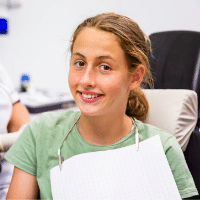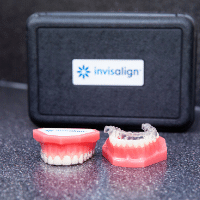Dental Crowding

Fixing Crowded Teeth
At a time when children are constantly exposed to social media depictions of perfect-looking teens, crowded teeth can be a real embarrassment.
We’ve all seen it in the schoolyard—children have lost some of their baby teeth, but also have a few giant adult teeth in a little child’s head—and it all looks a bit of a fright. Take comfort though—it’s not the end of the world at this early stage. Often, it all works out okay as baby teeth fall out and new teeth come through, but seeing a dentist regularly to keep an eye on things is a good idea.
Assessing the Problem
The big question most parents ask their dentist is simple: When is the best time to seek treatment for crowded teeth? The answer is a little more complicated and, in truth, it all depends on each individual case.
A dentist can advise whether your child’s teeth are crowded, or if there is an issue with jaw alignment. If children have a big overbite or underbite, it’s generally advisable to do some treatments earlier rather than later because the aim is to subtly change the way their jaws are growing.
For this to be effective, treatment should happen before a child hits the puberty growth spurt. That typically means around the age of nine or ten and, in many cases, a dentist will recommend seeing an orthodontist for specialist corrective work.
Expansion devices can be used, for example, to prevent crowding and crossbites for children with a narrow top arch, while other devices can help the bottom jaw grow forward and achieve better alignment.
Taking Appropriate Action
The beauty of getting work done at an early age is that it can minimise the need for major orthodontic work down the track. If you can make early corrections, the teeth will generally have a better chance of being straight when it’s time for them to come through properly.
If your child has only crowding/cosmetic issues rather than jaw alignment problems, you can generally put off orthodontic treatment until they lose all their baby teeth and their molars are through. In most cases, that happens from age 11 through to 14. Nevertheless, remember that it’s important to make a fairly early call on whether there are issues associated with the growth of your child’s jaw. This is where your dentist’s advice is invaluable.
Choosing Conventional Braces or Invisalign
The other big debate for parents and their children is whether to opt for braces or to use clear-aligner treatments such as Invisalign. Given their relatively high cost, Invisalign has sometimes been the reserve of older people in the past, but more and more children are choosing this option.
It’s a softer aesthetic look, and it also means they don’t have to worry so much about getting hit in the mouth at football or netball, or other such issues. Remember, though, not everyone is suitable for Invisalign. It’s also important for parents—and children—to remember that the results when using braces or Invisalign are comparable. So, the final choice should really be made based on a family’s circumstance and the view of your dentist or orthodontist. The key is to make smart, informed choices.
The content has been made available for informational and educational purposes only. Plaza Dental does not make any representation or warranties with respect to the accuracy, applicability, fitness, or completeness of the content.
The content is not intended to be a substitute for professional personal diagnosis or treatment. Always seek the advice of your dentist or another qualified health provider with any questions you may have regarding a dental or medical condition. Never disregard professional advice or delay seeking it because of something you have read or seen on the Site.
Services we mentioned:
Related Articles
Philanthropy in Dentistry: Dental Charities Have a Lot to Give
Australia is in the midst of a cost of living crisis following the global Coronavirus pandemic. It seems, as if...
What Is the Cost of Orthodontic Treatment
This is one of the most common questions we had asked, how much will it cost to straighten my teeth. Unfortunately the...









